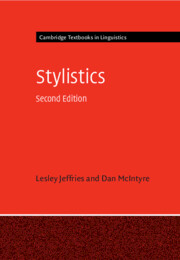Refine search
Actions for selected content:
277 results
Relative importance of lexical features in word processing during L2 English reading
-
- Journal:
- Studies in Second Language Acquisition , First View
- Published online by Cambridge University Press:
- 29 August 2025, pp. 1-24
-
- Article
-
- You have access
- Open access
- HTML
- Export citation

How the World Became a Book in Shakespeare's England
-
- Published online:
- 09 August 2025
- Print publication:
- 14 August 2025

The Imagination Pulse
- From Flickers to Firestorms in Reading
-
- Published online:
- 08 August 2025
- Print publication:
- 04 September 2025
-
- Element
- Export citation
First-language and second-language eye movement reading behavior in monolingual and bilingual children and adults: A focus on word age of acquisition effects
-
- Journal:
- Bilingualism: Language and Cognition , First View
- Published online by Cambridge University Press:
- 28 July 2025, pp. 1-13
-
- Article
-
- You have access
- Open access
- HTML
- Export citation
The influence of text segmentation on garden path processing: evidence from self-paced reading and eye-tracking
-
- Journal:
- Language and Cognition / Volume 17 / 2025
- Published online by Cambridge University Press:
- 24 July 2025, e58
-
- Article
-
- You have access
- Open access
- HTML
- Export citation
20 - Literacies for Teaching
- from Part V - Practice
-
-
- Book:
- The Cambridge Handbook of Technology in Language Teaching and Learning
- Published online:
- 15 June 2025
- Print publication:
- 26 June 2025, pp 332-347
-
- Chapter
- Export citation
Direction of reading, not writing, shapes concepts of time
-
- Journal:
- Language and Cognition / Volume 17 / 2025
- Published online by Cambridge University Press:
- 02 June 2025, e49
-
- Article
-
- You have access
- Open access
- HTML
- Export citation
2 - Attention in Everyday Life
-
- Book:
- Neuroscience of Attention
- Published online:
- 02 May 2025
- Print publication:
- 22 May 2025, pp 32-57
-
- Chapter
- Export citation
Chapter 9 - English Literature to 1792
- from Part II - Intellectual, Cultural, and Political Contexts
-
-
- Book:
- Percy Shelley in Context
- Published online:
- 17 April 2025
- Print publication:
- 24 April 2025, pp 67-73
-
- Chapter
- Export citation
Reading comprehension of children acquiring a transparent language as L2: A study with the simple view of reading model
-
- Journal:
- Bilingualism: Language and Cognition , First View
- Published online by Cambridge University Press:
- 14 April 2025, pp. 1-15
-
- Article
-
- You have access
- Open access
- HTML
- Export citation
Chapter Nine - Additional Forms of Language Communication
-
- Book:
- The Neuroscience of Language
- Published online:
- 17 April 2025
- Print publication:
- 10 April 2025, pp 197-215
-
- Chapter
- Export citation
New data on text reading in English as a second language: The Wave 2 expansion of the Multilingual Eye-Movement Corpus (MECO)
-
- Journal:
- Studies in Second Language Acquisition / Volume 47 / Issue 2 / May 2025
- Published online by Cambridge University Press:
- 12 March 2025, pp. 677-695
- Print publication:
- May 2025
-
- Article
-
- You have access
- Open access
- HTML
- Export citation

Stylistics
-
- Published online:
- 18 February 2025
- Print publication:
- 09 January 2025
-
- Textbook
- Export citation
Learning Irony in School: Effects of Metapragmatic Training
-
- Journal:
- Journal of Child Language , First View
- Published online by Cambridge University Press:
- 18 February 2025, pp. 1-22
-
- Article
-
- You have access
- Open access
- HTML
- Export citation
Chapter 2 - Reading, Feeling, Acting
- from Part I - Protest
-
- Book:
- Vivisection and Late-Victorian Literary Culture
- Published online:
- 30 January 2025
- Print publication:
- 06 February 2025, pp 49-70
-
- Chapter
- Export citation
Chapter 4 - Materiality, Convenience, and Customisation
-
- Book:
- E-books and ‘Real Books’
- Published online:
- 07 December 2024
- Print publication:
- 23 January 2025, pp 93-132
-
- Chapter
-
- You have access
- Open access
- HTML
- Export citation
The effect of the global language context on bilingual language control during L1 reading
-
- Journal:
- Bilingualism: Language and Cognition / Volume 28 / Issue 2 / March 2025
- Published online by Cambridge University Press:
- 16 January 2025, pp. 577-587
-
- Article
-
- You have access
- Open access
- HTML
- Export citation
8 - Stylistics
-
- Book:
- Stylistics
- Published online:
- 18 February 2025
- Print publication:
- 09 January 2025, pp 263-278
-
- Chapter
- Export citation
Local vs. Global Covert Visual Attention: Are Two States Necessary? Comment on Liechty et al., 2003
-
- Journal:
- Psychometrika / Volume 68 / Issue 4 / December 2003
- Published online by Cambridge University Press:
- 01 January 2025, pp. 543-549
-
- Article
- Export citation
Differentiating the neurobiological correlates for reading gains in children with reading difficulties with and without attention-deficit/hyperactivity disorder using fMRI
-
- Journal:
- Journal of the International Neuropsychological Society / Volume 31 / Issue 1 / January 2025
- Published online by Cambridge University Press:
- 27 December 2024, pp. 75-85
-
- Article
-
- You have access
- Open access
- HTML
- Export citation
